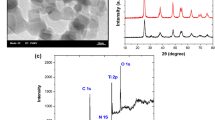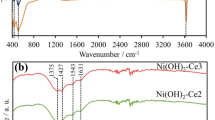Abstract
Anatase phase NOx/S6+–TiO2 (x = 0, 1) film with high solar-driven activity has been successfully prepared via electro-assisted oxidation processes. The morphological and structural properties of the film were characterized by scanning electron microscopy, transmission electron microscopy, X-ray photoelectron spectroscopy, and X-ray diffraction, while the optical property was detected by UV-vis-NIR absorption spectroscopy. The results showed that the NOx/S6+–TiO2 film was composed of “flower-like” microvoids structure and displayed broad and strong optical absorption at around 544 and 1500 nm. Transient photocurrent response, photoluminescence spectroscopy, and electrochemical impedance spectroscopy indicated that the generation and separation of photogenerated charges were significantly enhanced under simulated solar irradiation. The NOx/S6+–TiO2 film exhibited excellent photoelectrocatalytic activity for the degradation of methyl orange (MO), and the decoloration rate and TOC removal respectively reached 98.97 and 59.44% at 20 min under solar irradiation. The film still had good stability after reusing ten times. Furthermore, a possible mechanism of photoelectrocatalysis was suggested in MO degradation by using NOx/S6+–TiO2 film.








Similar content being viewed by others
References
A. Brindha and T. Sivakumar: Visible active N,S co-doped TiO2/graphene photocatalysts for the degradation of hazardous dyes. J. Photochem. Photobiol., A 340, 146 (2017).
X. Li, J. Xie, C. Jiang, J. Yu, and P. Zhang: Review on design and evaluation of environmental photocatalysts. Front. Environ. Sci. Eng. 12, 14 (2018).
S. Garcia-Segura and E. Brillas: Applied photoelectrocatalysis on the degradation of organic pollutants in wastewaters. J. Photochem. Photobiol., C 31, 1 (2017).
C. Liu, Y. Ding, W. Wu, and Y. Teng: A simple and effective strategy to fast remove chromium(VI) and organic pollutant in photoelectrocatalytic process at low voltage. Chem. Eng. J. 306, 22 (2016).
Q. Wang, N. Zhu, E. Liu, C. Zhang, J.C. Crittenden, Y. Zhang, and Y. Cong: Fabrication of visible-light active Fe2O3-GQDs/NF-TiO2 composite film with highly enhanced photoelectrocatalytic performance. Appl. Catal., B 205, 347 (2017).
Z. Lyu, B. Liu, R. Wang, and L. Tian: Synergy of palladium species and hydrogenation for enhanced photocatalytic activity of (001) facets dominant TiO2 nanosheets. J. Mater. Res. 32, 2781 (2017).
X. Zhou, Y. Zheng, J. Zhou, and S. Zhou: Degradation kinetics of photoelectrocatalysis on landfill leachate using codoped TiO2/Ti photoelectrodes. J. Nanomater. 2015, 7 (2015).
H. Kmentová, D. Nandan, Š. Kment, A. Naldoni, M.B. Gawande, Z. Hubička, and R. Zbořil: Significant enhancement of photoactivity in one-dimensional TiO2 nanorods modified by S-, N-, O-doped carbon nanosheets. Catal. Today 328, 111 (2019).
N. Rahimi, R.A. Pax, and E.M. Gray: Review of functional titanium oxides. I: TiO2 and its modifications. Prog. Solid State Chem. 44, 86 (2016).
C. Li, Z. Zhao, H. Shindume Lomboleni, H. Huang, and Z. Peng: Enhanced visible photocatalytic activity of nitrogen doped single-crystal-like TiO2 by synergistic treatment with urea and mixed nitrates. J. Mater. Res. 32, 737 (2016).
R. Daghrir, P. Drogui, N. Delegan, and M.A. El-Khakani: Electrochemical degradation of chlortetracycline using N-doped Ti/TiO2 photoanode under sunlight irradiations. Water Res. 47, 6801 (2013).
T. Umebayashi, T. Yamaki, H. Itoh, and K. Asai: Band gap narrowing of titanium dioxide by sulfur doping. Appl. Phys. Lett. 81, 454 (2002).
D.M. Andoshe, K. Yim, W. Sohn, C. Kim, T.L. Kim, K.C. Kwon, K. Hong, S. Choi, C.W. Moon, S-P. Hong, S. Han, and H-W. Jang: One-pot synthesis of sulfur and nitrogen codoped titanium dioxide nanorod arrays for superior photoelectrochemical water oxidation. Appl. Catal., B 234, 213 (2018).
X. Chen and C. Burda: Photoelectron spectroscopic investigation of nitrogen-doped titania nanoparticles. J. Phys. Chem. B 108, 15446 (2004).
R. Asahi and T. Morikawa: Nitrogen complex species and its chemical nature in TiO2 for visible-light sensitized photocatalysis. Chem. Phys. 339, 57 (2007).
M.M. Momeni, Y. Ghayeb, and Z. Ghonchegi: Visible light activity of sulfur-doped TiO2 nanostructure photoelectrodes prepared by single-step electrochemical anodizing process. J. Solid State Electrochem. 19, 1359 (2015).
W-S. Chen and C-P. Huang: Mineralization of aniline in aqueous solution by electrochemical activation of persulfate. Chemosphere 125, 175 (2015).
Y. Deng and C.M. Ezyske: Sulfate radical-advanced oxidation process (SR-AOP) for simultaneous removal of refractory organic contaminants and ammonia in landfill leachate. Water Res. 45, 6189 (2011).
L. Gomathi-Devi and R. Kavitha: Review on modified N–TiO2 for green energy applications under UV/visible light: Selected results and reaction mechanisms. RSC Adv. 4, 28265 (2014).
C. McManamon, J. O’Connell, P. Delaney, S. Rasappa, J.D. Holmes, and M.A. Morris: A facile route to synthesis of S-doped TiO2 nanoparticles for photocatalytic activity. J. Mol. Catal. A: Chem. 406, 51 (2015).
G. Yang, T. Wang, B. Yang, Z. Yan, S. Ding, and T. Xiao: Enhanced visible-light activity of F–N co-doped TiO2 nanocrystals via nonmetal impurity, Ti3+ ions and oxygen vacancies. Appl. Surf. Sci. 287, 135 (2013).
J-M. Wu and J-X. Yin: A facile solution-based approach to a photocatalytic active branched one-dimensional TiO2 array. RSC Adv. 5, 3465 (2015).
V.I. Sysoev, A.V. Okotrub, A.V. Gusel’nikov, D.A. Smirnov, and L.G. Bulusheva: In situ XPS observation of selective NOx adsorption on the oxygenated graphene films. Phys. Status Solidi B 255, 1700267 (2018).
M. Bendova, J. Kolar, M. Marik, T. Lednicky, and A. Mozalev: Influence of nitrogen species on the porous-alumina-assisted growth of TiO2 nanocolumn arrays. Electrochim. Acta 281, 796 (2018).
Y. Fan, C. Ma, B. Liu, H. Chen, L. Dong, and Y. Yin: Nitrogen doped anatase TiO2 sheets with dominant (001) facets for enhancing visible-light photocatalytic activity. Mater. Sci. Semicond. Process. 27, 47 (2014).
X. Cheng, H. Liu, Q. Chen, J. Li, and P. Wang: Construction of N, S codoped TiO2 NCs decorated TiO2 nano-tube array photoelectrode and its enhanced visible light photocatalytic mechanism. Electrochim. Acta 103, 134 (2013).
X-B. Chen and B. Clemens: The electronic origin of the visible-light absorption properties of C-, N- and S-doped TiO2 nanomaterials. J. Am. Chem. Soc. 130, 5018 (2008).
Z. Zhang and P. Wang: Optimization of photoelectrochemical water splitting performance on hierarchical TiO2 nanotube arrays. Energy Environ. Sci. 5, 6506 (2012).
D. Wei: Formation and crystallization characteristics of anodic oxide film on pure titanium in potentiostatic mode. J. South China Univ. Technol. 40, 30 (2012).
A. Mazzarolo, M. Curioni, A. Vicenzo, P. Skeldon, and G.E. Thompson: Anodic growth of titanium oxide: Electrochemical behaviour and morphological evolution. Electrochim. Acta 75, 288 (2012).
X-B. Chen, P-A. Glans, X. Qiu, S. Dayal, W.D. Jennings, K.E. Smith, C. Burda, and J. Guo: X-ray spectroscopic study of the electronic structure of visible-light responsive N-, C- and S-doped TiO2. J. Electron Spectrosc. Relat. Phenom. 162, 67 (2008).
J. Manju and S.M. Joseph-Jawhar: Synthesis of magnesium-doped TiO2 photoelectrodes for dye-sensitized solar cell applications by solvothermal microwave irradiation method. J. Mater. Res. 33, 1534 (2018).
Y. Pan, Y. Shen, Q. Jin, and S. Zhu: Promotional effect of Ba additives on MnCeOx/TiO2 catalysts for NH3-SCR of NO at low temperature. J. Mater. Res. 33, 2414 (2018).
F. Li, T. Han, H. Wang, X. Zheng, J. Wan, and B. Ni: Morphology evolution and visible light driven photocatalysis study of Ti3+ self-doped TiO2−x nanocrystals. J. Mater. Res. 32, 1563 (2017).
L. Yan, S. Dong, Y. Zhang, L. Wang, Y. Gang, S. Fei, S. Deng, X. Zhang, and S. Zhang: Anodized TiO2 nanotubes coated with Pt nanoparticles for enhanced photoelectrocatalytic activity. J. Mater. Res. 32, 757 (2017).
M. Behpour and V. Atouf: Study of the photocatalytic activity of nanocrystalline S,N-codoped TiO2 thin films and powders under visible and sun light irradiation. Appl. Surf. Sci. 258, 6595 (2012).
A.P. Bhirud, S.D. Sathaye, R.P. Waichal, J.D. Ambekar, C.J. Park, and B.B. Kale: In situ preparation of N–TiO2/graphene nanocomposite and its enhanced photocatalytic hydrogen production by H2S splitting under solar light. Nanoscale 7, 5023 (2015).
J. Li, X. Xu, X. Liu, W. Qin, and L. Pan: Novel cake-like N-doped anatase/rutile mixed phase TiO2 derived from metal–organic frameworks for visible light photocatalysis. Ceram. Int. 43, 835 (2017).
Y. Liu, K. Mu, J. Zhong, K. Chen, Y. Zhang, G. Yang, L. Wang, S. Deng, F. Shen, and X. Zhang: Design of a solar-driven TiO2 nanofilm on Ti foil by self-structure modifications. RSC Adv. 5, 41437 (2015).
F. Zhou, H. Song, H. Wang, S. Komarneni, and C. Yan: N-doped TiO2/sepiolite nanocomposites with enhanced visible-light catalysis: Role of N precursors. Appl. Clay Sci. 166, 9 (2018).
W. Zhang, C. Wang, X. Liu, and J. Li: Enhanced photocatalytic activity in porphyrin-sensitized TiO2 nanorods. J. Mater. Res. 32, 2773 (2017).
F. Wu, X. Li, W. Liu, and S. Zhang: Highly enhanced photocatalytic degradation of methylene blue over the indirect all-solid-state Z-scheme g-C3N4-RGO-TiO2 nanoheterojunctions. Appl. Clay Sci. 405, 60 (2017).
J. Wen, X. Li, W. Liu, Y. Fang, J. Xie, and Y. Xu: Photocatalysis fundamentals and surface modification of TiO2 nanomaterials. Chin. J. Catal. 36, 2049 (2015).
M.M. Islam and S. Basu: Understanding photoelectrochemical degradation of methyl orange using TiO2/Ti mesh as photocathode under visible light. J. Environ. Chem. Eng. 4, 3554 (2016).
D. Liu, J. Zhou, J. Wang, R. Tian, X. Li, E. Nie, X. Piao, and Z. Sun: Enhanced visible light photoelectrocatalytic degradation of organic contaminants by F and Sn co-doped TiO2 photoelectrode. Chem. Eng. J. 344, 332 (2018).
C. Chen, W. Ma, and J. Zhao: ChemInform abstract: Semiconductor-mediated photodegradation of pollutants under visible-light irradiation. Chem. Soc. Rev. 39, 4206 (2010).
Y. Zhang, D. Gu, L. Zhu, and B. Wang: Highly ordered Fe3+/TiO2 nanotube arrays for efficient photocataltyic degradation of nitrobenzene. Appl. Surf. Sci. 420, 896 (2017).
Q. Ma, H. Wang, H. Zhang, X. Cheng, M. Xie, and Q. Cheng: Fabrication of MnO2/TiO2 nanotube arrays photoelectrode and its enhanced visible light photoelectrocatalytic performance and mechanism. Sep. Purif. Technol. 189, 193 (2017).
Acknowledgments
This work was supported by the Science and Technology Department of Sichuan Province (2017JZ0021, 2017SZ0039) and the Education Department of Sichuan Province (17ZA0298).
Author information
Authors and Affiliations
Corresponding author
Supplementary Material
Rights and permissions
About this article
Cite this article
Li, C., Liu, Y., Zhang, Y. et al. Electro-assisted ammonium persulfate activation to promote the introduction of N and S into TiO2 film: Enhancing its photoelectrocatalytic performance under solar. Journal of Materials Research 34, 3573–3582 (2019). https://doi.org/10.1557/jmr.2019.274
Received:
Accepted:
Published:
Issue Date:
DOI: https://doi.org/10.1557/jmr.2019.274




